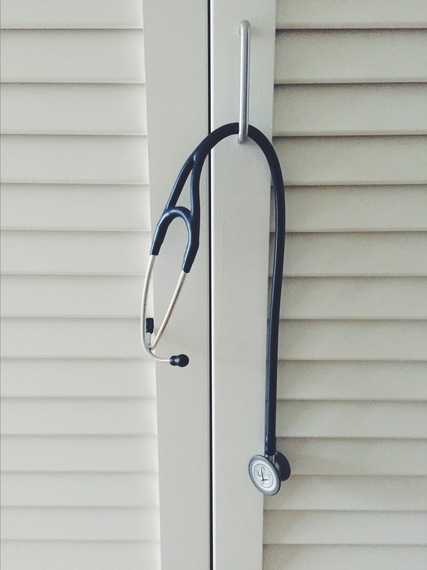Stethoscope, the versatile, resourceful, companion of all in a white coat died today. It was 200 years old. An insightful instrument that always provided an opportunity to discern the acoustic nuances of patient's heart and lungs died after accelerated technological advances in diagnostics.
Ultrasonography, commonly known as Ultrasound, [Latin ultra (on the farside/beyond), soni (sound), graphia (a form or process of)], a close associate and partner, confirmed the death.
In a statement, Dr. Eric Topol, influential Cardiologist and Medscape Editor-in-Chief, stated, "Stethoscope is dead. Sadly it was only a matter of time. We have little reason now to only listen to a patient's heartbeat."
Stethoscope is celebrated by its contribution to medical care when healthcare was nascent. It was born out of respect and the desire to care for a patient. Its spirit will continue on to many students of medicine. Though primitive, the advent of stethoscope was a bold move at a time where healthcare was only commencing its journey to shed light on disease states.
Stethoscope [Greek stethos (chest/breast), skopein (look at/explore)] was nearly for two centuries medicine's most influential instrument. Born to the French physician and inventor Rene' Laennec in Paris, France in 1816. Laennec himself was known to many as the father of auscultation, the act of listening to the heart, lungs and other organs. The original inspiration came when Laennec had a female patient and felt that the traditional means of placing his own ear on her chest was not respectful. From rolled sheets of paper creating a cone, Stethoscope over the next few years of infancy evolved into a hollow tube of wood, 3.5 cm in diameter and 25 cm long. Stethoscope was monoaural, held to one ear, the other end to the patient's chest.
Stethoscope's coming of age arrived in 1852 when under the guidance of New York physician, George Cammann, who adopted a binaural, using both ears, instrument. . During Stethoscope's evolution, experimentations were conducted with various metals and material such as ivory for the earpieces were used to maximize the acoustics. The tubes were made of coils of wires between rubber.
Almost a century later, Stethoscope came of age while at Harvard Medical School under professor David Littmann. Dr Littmann shaped Stethoscope to what many of today refer to as its modern form: an instrument with the ability to detect low frequency sound with the bell or to detect high frequency with the diaphragm of Stethoscope, short tubing that all culminating in allowing for it to be light enough to travel everywhere.
Prior to its death, Stethoscope became a double lumen (two tubes in one) latex tube, with soft ear tips and reversible bell to listen for various pitches. Today, thousands of medical professionals walk the hallways of hospitals and clinics, caring for millions of patients, all whose careers have been shaped by the influence of Stethoscope.
Stethoscope became the gold standard for many years in detection of murmurs, irregular heart rhythms, or abnormal heart sounds. Beyond the heart, Stethoscope also listened to the sound of air exchange in the lungs. The instrument continued to flourish in detecting possible pneumonias where a lung may have consolidation or detecting abnormal sounds during a patient's inhalation and exhalation.
However, during the lifespan of Stethoscope, controversy plagued its purposes where conversations revolved around its true value where further imaging and diagnostics proved to play a more influential role in patient care. The greatest point of disagreement revolved around the lack of dependence on auditory listening of physical ailments by healthcare professionals. Although the information attained can be useful, there was also a growing desire by patients to be examined by Stethoscope. "All good exams included Stethoscope," exclaimed one patient. It can be noted that the difficulties the medical profession faces with new technologies today are similar to the ones we saw back with Stethoscope's introduction in the early 1800s.
Stethoscope's optimal influence in the care of patients, many would argue, has been during the final years of formal medical education or early professional residency. Attainment of Stethoscope for many medical students became a reality that they have crossed into the sanctity of medicine. However, after early education, Stethoscope slowly evolved to only becoming a very preliminary method for diagnosis, preceding more advanced imaging that confirmed what had been suspected. Even during this time, though, Stethoscope was not used properly. Signs indicating the gradual shift away from its use.
Stethoscope has been a priceless instrument in medicine. In many areas, it will continue to be part of the basic care of a patient, e.g. listening to the lungs. However, along with providing our future medical practitioners the ability to listen, many have argued that we also need to help them see with new modalities. The future of medical care by our physicians is to become better diagnosticians.
A spokesperson from the medical community recently announced the advancement of Ultrasonography who will be playing an even greater role in the ensuing years and- in clinical diagnosis and beginning with integration into mobile technology and telecommunications. A pocket ultrasound machine that connects to an individual's cell phone, has now set the stage for medicine to be practiced in the 21st century.
Stethoscope had many loved ones in it's life and is survived by multimodal diagnostic care and, importantly, it's students who have carried on to become healthcare professionals, mastering the art of physical diagnosis and saving lives for centuries.
Stethoscope joins the Staff of Asclepius and a physician's black bag as one of the universal symbols for health and wellness. Stethoscope represented a move to maintain humanism while treating patients and, early on, a new technology in a developing field. It not only served as an ability to appreciate the heartbeat of a patient, but also the pulse of a field that is constantly evolving and being challenged. Stethoscope's death naturally has spawned modalities that provide meaningful results allowing for the transition of medical care into the 21st century.
